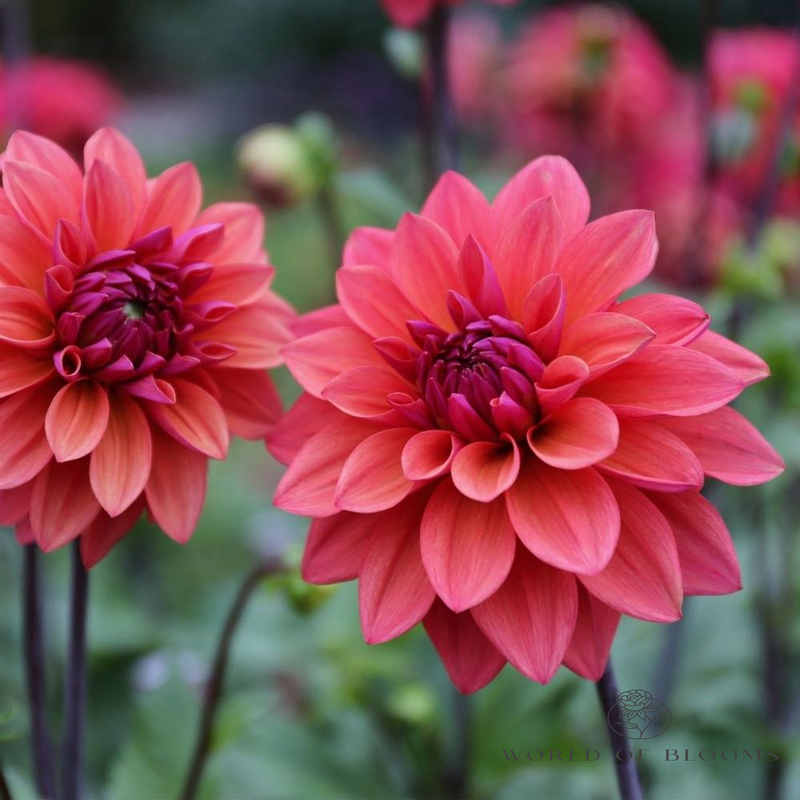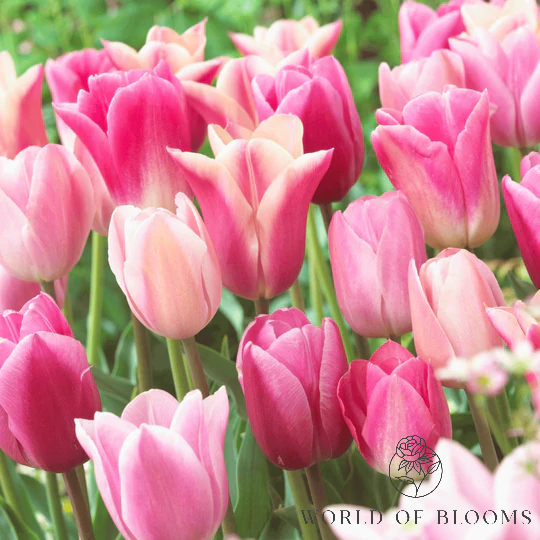Dahlia Decorative 'American Dawn'
Couldn't load pickup availability
Dahlia Decorative 'American Dawn' is a stunning variety of dahlia known for its large, showy blooms and vibrant colors. It is a striking, vibrant variety known for its beautiful sunset-colored blooms and upright growth habit. Its long flowering season and ability to attract pollinators make it an excellent addition to gardens, while its large, colorful flowers make it a fantastic choice for cut flower arrangements.
Zones: 3 - 11
General Characteristics:
- Type: Decorative Dahlia
- Flower Shape: The flowers are large, round, and slightly flattened. They have many petals, giving them a full and lush appearance.
- Bloom Color: The petals of the 'American Dawn' variety are a striking mix of orange, peach, and pink. The edges of the petals are often a deeper shade of orange, fading into softer peach and pink tones towards the center. This gradient effect creates a warm, sunset-like visual appeal.
- Flower Size: The blooms are large, typically ranging from 6 to 8 inches (15 to 20 cm) in diameter, making them highly noticeable in gardens or floral arrangements.
- Petal Texture: The petals are smooth and slightly curved, forming a beautiful, spiral-like pattern as they radiate outward from the center.
Plant Characteristics:
- Height: The plant typically grows to around 3 to 4 feet (90 to 120 cm) tall, making it suitable for both garden beds and containers.
- Spread: It tends to have a moderate spread, reaching around 18 to 24 inches (45 to 60 cm) wide.
- Foliage: The foliage is dark green, which provides a striking contrast against the vibrant flowers. The leaves are broad, pointed, and deeply lobed.
- Growth Habit: 'American Dawn' is a bushy, upright plant, often requiring staking or support as its large blooms can weigh down the stems.
Growing Conditions:
- Sunlight: Like most dahlias, 'American Dawn' thrives in full sun. It requires at least 6 hours of direct sunlight each day to produce the best blooms.
- Soil: Well-draining, rich, and slightly acidic soil is ideal for this dahlia variety. Adding organic compost or well-rotted manure can improve soil quality.
- Watering: Regular watering is necessary, but the soil should not be allowed to become waterlogged. Dahlia plants do best with consistently moist but not soggy soil.
- Hardiness Zone: 'American Dawn' is best suited for USDA zones 8 to 10, which means it thrives in regions with mild winters. In colder climates (zones 7 and below), the tubers will need to be dug up and stored indoors over the winter to prevent frost damage.
- Flowering Time: The 'American Dawn' dahlia begins flowering in mid-summer (usually from late June to early July) and continues blooming until the first frost in the fall, providing a long-lasting burst of color.
- Pollinators: This variety is attractive to bees, butterflies, and other pollinators, which help in the pollination of other plants in the garden.
Uses:
- Garden Beds: Dahlia 'American Dawn' is perfect for garden beds, providing a splash of color throughout the growing season.
- Cut Flowers: Due to the large size and vibrant color of the blooms, this variety is an excellent choice for cutting and displaying in vases. The flowers also have a good vase life, typically lasting for several days.
- Landscaping: Ideal for adding drama and color to borders, mixed beds, or even as a specimen plant in the garden.
Planting Instructions
1. Choosing the Right Location
Dahlias require specific growing conditions to thrive, so selecting the right spot is key:
- Sunlight: Dahlias love full sun. Choose a location that receives at least 6-8 hours of direct sunlight each day. The more sun they get, the better the blooming.
- Soil: Well-drained, fertile soil is essential. Dahlias do best in slightly acidic to neutral soil (pH 6.0 to 7.0). If your soil is heavy clay or drains poorly, amend it with organic matter (like compost) to improve drainage and fertility.
- Protection from Wind: Although dahlias are relatively tall and sturdy, they can be vulnerable to strong winds. Plant them in a sheltered spot to prevent breakage or damage to the flowers.
2. When to Plant Dahlias
Dahlias are warm-season flowers and should be planted once the threat of frost has passed and the soil has warmed up. In most regions, this means planting them in late spring, typically around late April to early May, after the last frost date.
- Soil Temperature: The ideal soil temperature for planting dahlia tubers is around 60°F (15°C). If the soil is too cold, the tubers may rot before they have a chance to sprout.
3. Preparing the Soil
Good soil preparation helps dahlias grow strong and healthy:
- Amend the Soil: Before planting, work compost or well-rotted manure into the soil. This adds nutrients and helps with drainage.
- Loosen the Soil: Dahlias have tubers that need to spread out, so make sure the soil is loose, not compacted.
- Add Fertilizer: Mix a slow-release balanced fertilizer or one specifically designed for flowering plants into the soil before planting to give your dahlias a nutrient boost.
4. Planting the Tubers
Once the soil is prepared, it's time to plant your dahlia tubers.
- Spacing: Dahlias should be spaced about 18-24 inches (45-60 cm) apart, depending on the variety. Taller varieties may need more space, while compact varieties can be planted a bit closer together.
- Planting Depth: Dig a hole or trench around 6 inches (15 cm) deep. Place the tuber in the hole with the "eyes" (small, bud-like protrusions) facing upward. If you’re planting multiple tubers, make sure there is enough room for the tubers to spread out as they grow.
- Orientation: If the tuber has a noticeable direction (like a flat side), plant it so that the eyes are facing upward. If unsure, it’s fine to plant the tuber sideways or with the flat side facing down.
- Covering: Gently cover the tuber with soil, and water it well after planting. Avoid burying the tuber too deeply; about 6 inches is ideal. The soil should be loose enough to allow the tuber to sprout easily.
5. Watering and Mulching
- Watering: After planting, water the area thoroughly to settle the soil around the tuber. Keep the soil evenly moist, but not soggy, while the tubers are establishing themselves. Once the plants start growing, they need consistent moisture, especially during dry spells.
- Mulching: Apply a thin layer of mulch around the plants to help retain moisture and suppress weeds. Organic mulch like straw, leaves, or grass clippings works well. However, avoid placing mulch directly on the tubers.
6. Staking or Supporting Dahlias
Dahlias can grow tall, especially larger varieties, so they may need support:
- Staking: To prevent the stems from flopping over, you can insert stakes near the plants and tie the stems loosely to the stakes. This is especially important for tall varieties or those with large flowers.
- Cages: Another option is to use a wire cage around the plant to provide support as it grows. This keeps the plant upright and the flowers undamaged by wind or rain.
7. Fertilizing and Care During the Growing Season
Once your dahlias are planted, it’s important to feed and care for them as they grow:
- Fertilizing: After planting, you can give dahlias a light dose of a high-phosphorus fertilizer to encourage blooming. Later in the growing season, switch to a balanced fertilizer or one that is lower in nitrogen. Over-fertilizing with too much nitrogen can result in lush foliage but fewer flowers.
- Deadheading: Remove spent blooms regularly to encourage new flowers and keep the plant looking tidy.
- Pruning: Prune the stems lightly to encourage branching. If you're growing large varieties, you may want to pinch off the top few buds to encourage bushier growth.
8. Aftercare and Harvesting
- Watering: Ensure that dahlias receive regular watering throughout the growing season, especially when the weather is hot and dry. The soil should stay moist but not waterlogged.
- Cutting Flowers: Dahlias are wonderful cut flowers! If you want to enjoy them indoors, cut them in the early morning or evening when they’re freshest, and place them in water immediately.
9. Overwintering Dahlias (for cold climates)
- Digging Up Tubers: In colder climates (zones 7 and below), you’ll need to dig up dahlia tubers before the first frost hits. Carefully lift the tubers with a spade or fork, being careful not to damage them. Trim the foliage and let the tubers dry for a couple of days in a cool, dry place.
- Storage: After drying, store the tubers in a cool, frost-free location, like a basement or garage, in a box with peat moss, sawdust, or sand to keep them dry. Check on the tubers periodically to make sure they haven’t rotted.




Recently viewed








